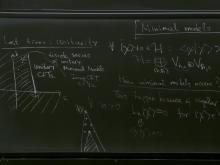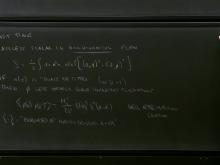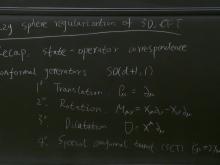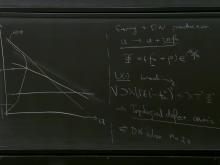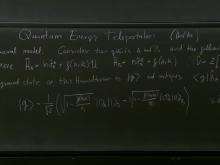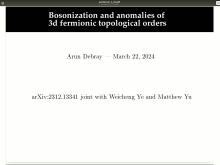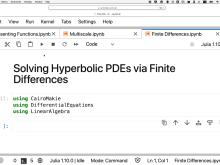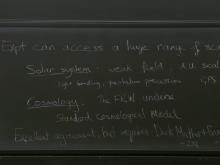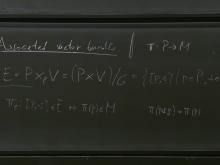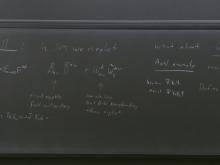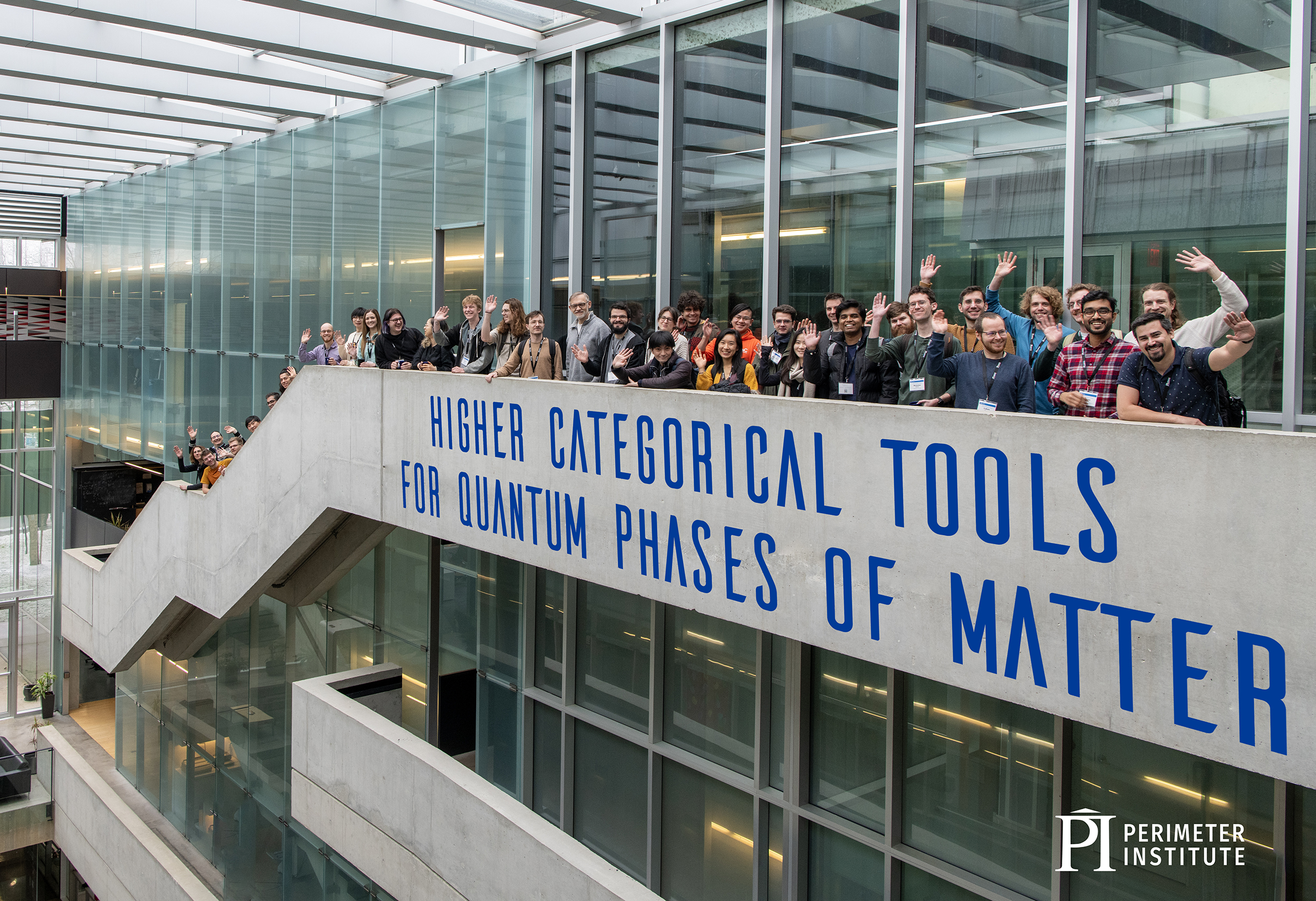Format results
-
13 talks-Collection NumberC24010
Talk
-

QFT III Lecture
Jaume Gomis Perimeter Institute for Theoretical Physics
-

QFT III Lecture
Jaume Gomis Perimeter Institute for Theoretical Physics
-

QFT III Lecture
Jaume Gomis Perimeter Institute for Theoretical Physics
-

QFT III Lecture
Jaume Gomis Perimeter Institute for Theoretical Physics
-

QFT III Lecture
Jaume Gomis Perimeter Institute for Theoretical Physics
-

QFT III Lecture
Mykola Semenyakin Perimeter Institute for Theoretical Physics
-

QFT III Lecture
Mykola Semenyakin Perimeter Institute for Theoretical Physics
-

QFT III Lecture
Mykola Semenyakin Perimeter Institute for Theoretical Physics
-
-
Cosmology 2023/24
13 talks-Collection NumberC24013Talk
-

Cosmology Lecture
Kendrick Smith Perimeter Institute for Theoretical Physics
-

Cosmology Lecture
Kendrick Smith Perimeter Institute for Theoretical Physics
-

Cosmology Lecture
Kendrick Smith Perimeter Institute for Theoretical Physics
-

Cosmology Lecture
Kendrick Smith Perimeter Institute for Theoretical Physics
-

Cosmology Lecture
Kendrick Smith Perimeter Institute for Theoretical Physics
-

Cosmology Lecture
Kendrick Smith Perimeter Institute for Theoretical Physics
-

Cosmology Lecture
Kendrick Smith Perimeter Institute for Theoretical Physics
-

Cosmology Lecture
Kendrick Smith Perimeter Institute for Theoretical Physics
-
-
Quantum Matter 2023/24
13 talks-Collection NumberC24011Talk
-

Quantum Matter Lecture
Timothy Hsieh Perimeter Institute for Theoretical Physics
-

Quantum Matter Lecture
Timothy Hsieh Perimeter Institute for Theoretical Physics
-

Quantum Matter Lecture
Timothy Hsieh Perimeter Institute for Theoretical Physics
-

-

-

-

-

-
-
Particle Physics
12 talks-Collection NumberC24009Talk
-

Particle Physics Lecture
Asimina Arvanitaki Perimeter Institute for Theoretical Physics
-

Particle Physics Lecture
Asimina Arvanitaki Perimeter Institute for Theoretical Physics
-

Particle Physics Lecture
Asimina Arvanitaki Perimeter Institute for Theoretical Physics
-

Particle Physics Lecture
Asimina Arvanitaki Perimeter Institute for Theoretical Physics
-

Particle Physics Lecture
Asimina Arvanitaki Perimeter Institute for Theoretical Physics
-

Particle Physics Lecture
Asimina Arvanitaki Perimeter Institute for Theoretical Physics
-

Particle Physics Lecture
Junwu Huang Perimeter Institute for Theoretical Physics
-

Particle Physics Lecture
Junwu Huang Perimeter Institute for Theoretical Physics
-
-
Quantum Information 2023/24
13 talks-Collection NumberC24012Talk
-

Quantum Information Lecture
Eduardo Martin-Martinez University of Waterloo
-

Quantum Information Lecture
Eduardo Martin-Martinez University of Waterloo
-

Quantum Information Lecture
Eduardo Martin-Martinez University of Waterloo
-

Quantum Information Lecture
Eduardo Martin-Martinez University of Waterloo
-

Quantum Information Lecture
Eduardo Martin-Martinez University of Waterloo
-

Quantum Information Lecture
Eduardo Martin-Martinez University of Waterloo
-

Quantum Information Lecture
Eduardo Martin-Martinez University of Waterloo
-

Quantum Information Lecture
Eduardo Martin-Martinez University of Waterloo
-
-
Higher Categorical Tools for Quantum Phases of Matter
15 talks-Collection NumberC24016Talk
-

-

Analogies between QFT and lattice systems
Anton Kapustin California Institute of Technology (Caltech) - Division of Physics Mathematics & Astronomy
-

Models of anyons with symmetry: a bulk-boundary correspondence
Fiona Burnell University of Minnesota
-

Twisted Tools for (Untwisted) Quantum Field Theory
Justin Kulp Stony Brook University
-

Quantum double models and Dijkgraaf-Witten theory with defects
Catherine Meusburger -

Topological sectors in quantum lattice models
Clement Delcamp Institut des Hautes Etudes Scientifiques (IHES)
-

Douglas-Reutter 4d TQFT as a generalised orbifold
Vincentas Mulevičius Vilnius University
-

Weak Hopf symmetric tensor networks
Andras Molnar University of Vienna
-
-
Dark Matter, First Light
26 talks-Collection NumberC24015Talk
-

Opening Remarks
-
Katherine Mack Perimeter Institute for Theoretical Physics
-
Aaron Vincent Queen's University
-
-

Dark and visible structures with dissipative dark matter
Sarah Shandera Pennsylvania State University
-

-

-

The First Stars in the Universe as Dark Matter Laboratories
Cosmin Ilie Colgate University
-

Probing Atomic Dark Matter using Simulated Galactic Subhalo Populations
Caleb Gemmell University of Toronto
-

Dark matter at high redshifts with JWST
Julian Munoz The University of Texas at Austin
-

(Dark) Baryogenesis through Asymmetric Reheating in the Mirror Twin Higgs.
Andrija Rasovic University of Toronto
-
-
Numerical Methods 2023/24
13 talks-Collection NumberC24004Talk
-
Gravitational Physics
13 talks-Collection NumberC24007Talk
-

Gravitational Physics Lecture - Zoom Only
Ruth Gregory King's College London
-

-

-

-

-

-

-

-
-
Mathematical Physics - Core 2023/24
12 talks-Collection NumberC24005Talk
-
Quantum Foundations
13 talks-Collection NumberC24008Talk
-

Quantum Foundations Lecture
Lucien Hardy Perimeter Institute for Theoretical Physics
-

Quantum Foundations Lecture
Lucien Hardy Perimeter Institute for Theoretical Physics
-

Quantum Foundations Lecture
Lucien Hardy Perimeter Institute for Theoretical Physics
-

Quantum Foundations Lecture
Lucien Hardy Perimeter Institute for Theoretical Physics
-

Quantum Foundations Lecture
Lucien Hardy Perimeter Institute for Theoretical Physics
-

Quantum Foundations Lecture
Lucien Hardy Perimeter Institute for Theoretical Physics
-

Quantum Foundations Lecture
Lucien Hardy Perimeter Institute for Theoretical Physics
-

Quantum Foundations Lecture
Lucien Hardy Perimeter Institute for Theoretical Physics
-
-
Standard Model 2023/24
13 talks-Collection NumberC24006Talk
-
QFT III 2023/24
13 talks-Collection NumberC24010This survey course introduces some advanced topics in quantum field theory and string theory. Topics may include anomalies, conformal field theory, and bosonic string theory and are subject to change depending on the topics covered in the TBD elective course.
-
Cosmology 2023/24
13 talks-Collection NumberC24013This Cosmology course will provide a theoretical overview of the standard cosmological model.
Topics will include: FRW universe, Thermal History, Inflation, Cosmological Perturbation Theory, Structure Formation and Quantum Initial Conditions. -
Quantum Matter 2023/24
13 talks-Collection NumberC24011This course will cover quantum phases of matter, with a focus on long-range entangled states, topological states, and quantum criticality.
-
Particle Physics
12 talks-Collection NumberC24009This course will cover phenomenological studies and experimental searches for new physics beyond the Standard Model, including: naturalness, extra dimension, supersymmetry, grand unification, dark matter candidates (WIMPs and axions) and their detection.
-
-
Higher Categorical Tools for Quantum Phases of Matter
15 talks-Collection NumberC24016Quantum phases have become a staple of modern physics, thanks to their appearance in fields as diverse as condensed matter physics, quantum field theory, quantum information processing, and topology. The description of quantum phases of matter requires novel mathematical tools that lie beyond the old symmetry breaking perspective on phases. Techniques from topological field theory, homotopy theory, and (higher) category theory show great potential for advancing our understanding of the characterization and classification of quantum phases. The goal of this workshop is to bring together experts from across mathematics and physics to discuss recent breakthroughs in these mathematical tools and their application to physical problems.
Scientific Organizers
Lukas Mueller
Alex Turzillo
Davide Gaiotto
Sponsored in part by the Simons Collaboration on Global Categorical Symmetries
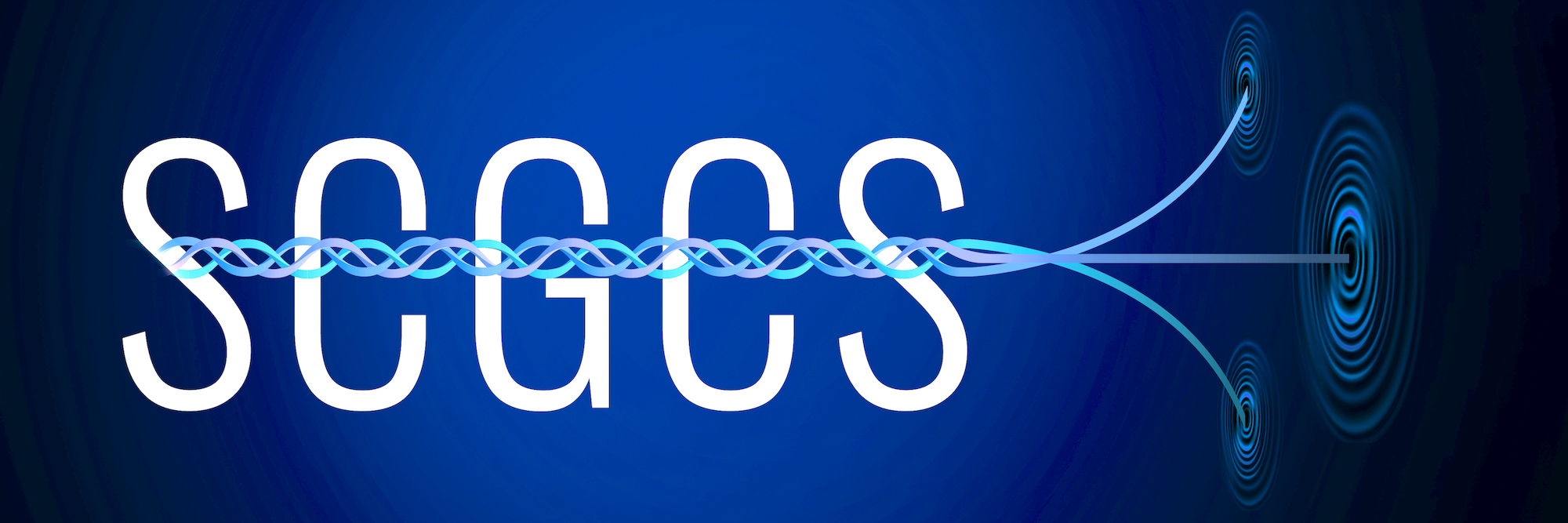
-
Dark Matter, First Light
26 talks-Collection NumberC24015New observational programs and techniques are opening a window to the first galaxies in the universe and bringing surprises along the way. In this workshop, we'll explore how dark matter phenomenology may have impacted the first stars and galaxies, focusing on how improved modeling and simulations can allow us to use new and upcoming high-redshift data to gain insight into dark matter's fundamental nature.
Sponsored in part by:

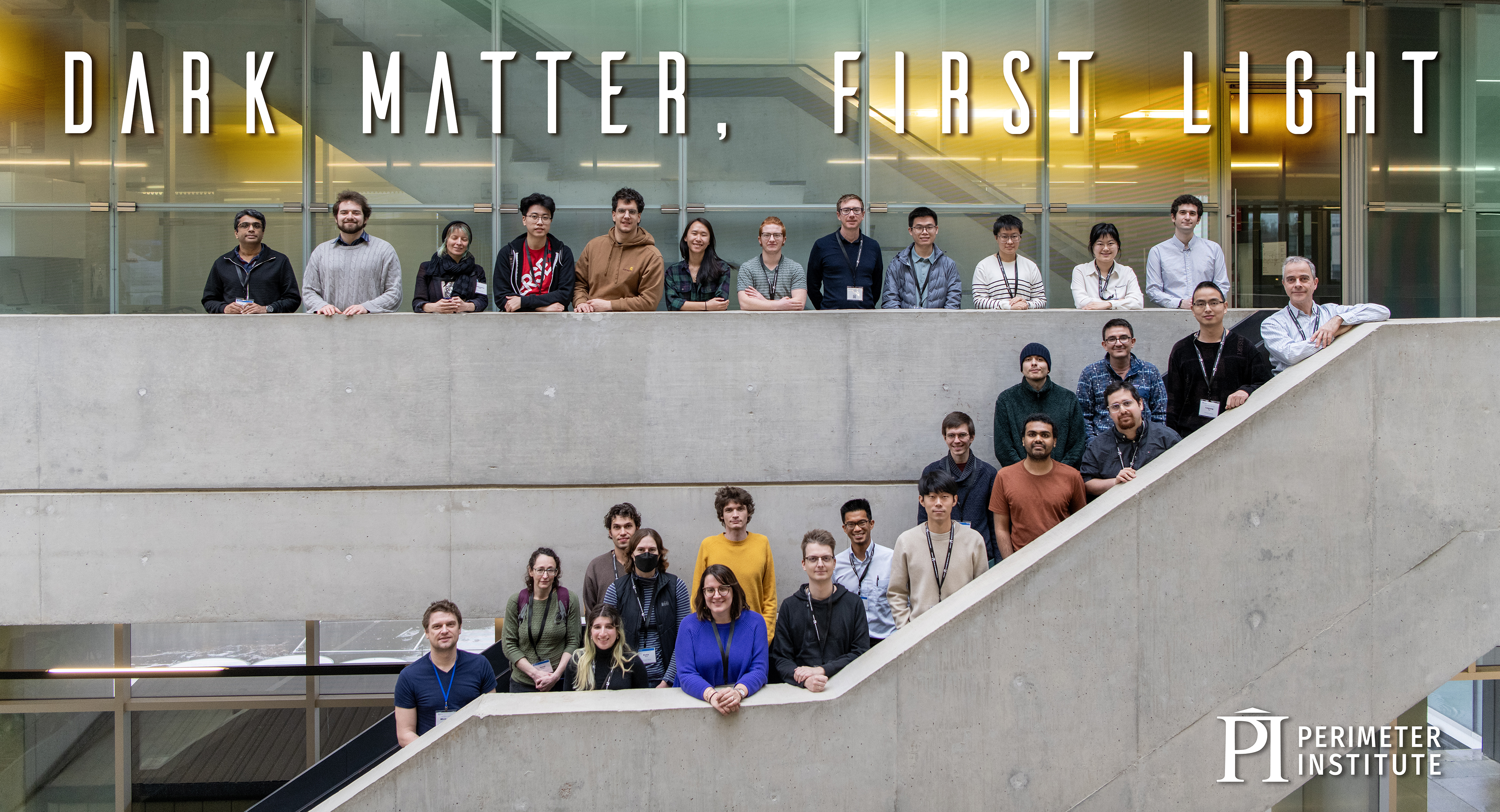
-
-
Gravitational Physics
13 talks-Collection NumberC24007The Gravitational Physics course takes your knowledge and practice of gravity to the next level. We start by recapping the essential elements of differential geometry, adding some new techniques to the toolbox, then apply some of these methods to learning about submanifolds, extra dimensions, and black hole thermodynamics. Towards the end of the course, we delve into the frontiers, with a sample of recent research topics.
-
Mathematical Physics - Core 2023/24
12 talks-Collection NumberC24005This course will introduce you to some of the geometrical structures underlying theoretical physics. Previous knowledge of differential geometry is not required. Topics covered in the course include: Introduction to manifolds, differential forms, symplectic manifolds, symplectic version of Noether’s theorem, integration on manifolds, fiber bundles, principal bundles and applications to gauge theory.
-
-
Standard Model 2023/24
13 talks-Collection NumberC24006The Standard Model of particle physics is introduced, and reviewed, from a modern effective field theory perspective.
